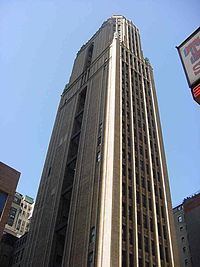Status Complete Cost $2,000,000 in 1917 Height 132 m Opened 1918 Construction started 1916 | Completed 1918 Roof 433 ft (132 m) Floors 30 | |
 | ||
Type Commercial meeting space and display spaceConverted to offices, 1938 Location 130-132 West 42nd StreetNew York, New YorkUSA Similar Industry City, 1095 Avenue of the Ameri, Verizon Building, McGraw‑Hill Building, Equitable Building | ||
Bush Tower, also called the Bush Terminal International Exhibit Building is a historic thirty-story skyscraper located just east of Times Square at 130-132 West 42nd Street between Broadway and Sixth Avenue in Midtown Manhattan, New York City. It was built in 1916–18 for Irving T. Bush's Bush Terminal Company, owners of Bush Terminal in Sunset Park, Brooklyn. Bush Tower's unique original purpose as commercial display space and social space, its notable design that combined narrowness, height, and Neo-Gothic architecture, and its role in the evolution of Times Square and of New York skyscrapers after the 1916 Zoning Resolution all qualify it as an exceptional structure.
Contents
Map of Bush Tower, New York, NY 10036, USA
Concept
Under Irving T. Bush (who has no relation to the Bush political family) the Bush Terminal Co. created Bush Tower to bring buyers, manufacturers, and designers together. As such, the company promoted a "vast centralized marketplace under one roof where complete lines of goods can be examined without loss of time".
The tower's lowest three floors were planned for the comfort and convenience of buyers visiting New York. These floors were modeled after a traditional large metropolitan private club and housed the newly created International Buyers Club, which contained "that mysterious element called 'atmosphere' and 'social standing'", yet representatives of any "reputable" firm could join for free. The company wrote these floors were also designed to be "welcoming of women members".
The club offered conference rooms, multiple lounges (including "retiring rooms" for both ladies and gentlemen), offices, buffet service, and a large second-floor reading room staffed with trained librarians. The third-floor auditorium could host lectures, concerts, the viewing of manufacturers' own promotional motion pictures, or even "fashion parades" for "displaying gowns."
These lowest floors featured extensive oak panelling, oriental carpets and antique furniture; according to the company's published promotional literature, this "Old English" style gave one "the feeling of having entered a hundred-year-old tavern".
The upper 27 stories held displays of manufacturers' goods, a concept explained as "the museum idea applied to commerce" by a writer for the Metropolitan Museum of Art's Bulletin.
The Bush Terminal Company attempted a similar melding of commercial displays and social space at Bush House in London, built in three phases during the 1920s, but the concept was not fully carried through at that project.
Building site and style
The building site was only 50 feet wide and 90 feet deep (15 m × 27.5 m), yet the building rises over 433 feet (132 m) to its peak. The architects remarked that they wanted to make the building "a model for the tall, narrow building in the center of a city block".
The New York firm of Helmle and Corbett (also designers of Bush House in London and the George Washington Masonic National Memorial (1922–1932) in Alexandria, Virginia)--and specifically, architect Harvey Wiley Corbett—gave Bush Tower a Neo-Gothic appearance, in some ways similar in style to New York's landmark Woolworth Building, a skyscraper that had been completed just three years earlier.
Yet the thinness of the building and its function precluded the need for conventional skyscraper fenestration. The windows are concentrated on the north (42nd St.) and south facades. With the exception of a recessed mid-facade lightwell on the east facade, the east and west walls were left largely blank. Instead, Trompe-l'œil brickwork creates vertical "ribs" with a false "shade" pattern to enhance the verticality. High pointed arched windows lighted the top double-height floor (the building is variously described as 29 or 30 floors). Even the water tower was hidden behind a mansard roof at the tower's peak.
Bush Tower influenced subsequent skyscraper design. Architect Raymond Hood credited the architects of this structure as an influence on his landmark American Radiator Building of 1924. Written about in the Literary Digest and Vanity Fair, and by such critics as Lewis Mumford in Architecture, and the tallest building in Midtown Manhattan when completed, Bush Tower also signified the movement of the Manhattan business district to Midtown.
Subsequent history
The Buyers' Club on the lower floors was quickly replaced by a bank in the early 1920s, then by the Old London Restaurant in 1931. After the Metropolitan Life Insurance Company foreclosed upon the tower in 1938 the upper floors were converted for regular office usage. By the early 1980s, the Times Square neighborhood and Bush Tower itself had deteriorated to the point where the owners considered demolishing the building. But it was instead renovated, with heating and electrical systems replaced throughout. The skyscraper was acquired in the 1980s by its present owners, by the Lebanese Dalloul family.
In 2002, the owners made public their plans for a new building immediately to the west of Bush Tower. In a design by the firm of Gruzen Samton, a 23-story glass tower would be separated by a six inch/15 cm gap—necessitated by earthquake codes—but connected on every floor to double the original building's space. But in October 2006, Dubai-based developer Istithmar announced they were purchasing the properties at 136-140 West 42nd St., between Bush Tower and Istithmar-owned 6 Times Square (formerly the Knickerbocker Hotel) Isithmar's plans to build a hotel/condominium building presumably signals an end for the office tower scheme, which had been developed through architectural working drawings.
